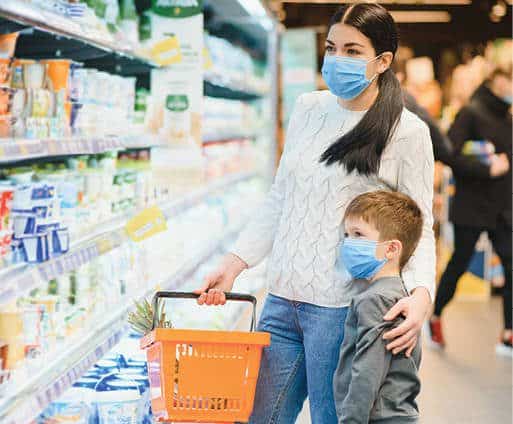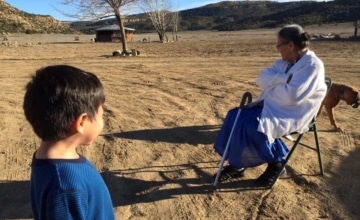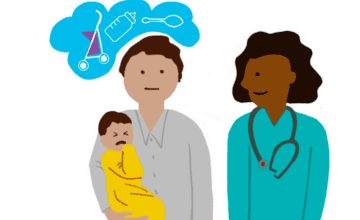Melissa Buchholz, Kelly Glaze, Catherine Wolcott, and Ayelet Talmi, University of Colorado School of Medicine, Children’s Hospital Colorado, Aurora, Colorado

Abstract
Primary care is an essential service for young children and one of the few settings where in-person care was provided during COVID-19 (recommended by the American Academy of Pediatrics, 2020). The HealthySteps (HS) model provides enhanced primary care to young children but required innovations to service delivery to adhere to public health orders and reduce virus exposure. The HS team in this clinic developed innovative service delivery strategies to continue providing comprehensive care to young children and families. The team also provides support to primary care medical colleagues as they navigate the ongoing challenges brought about by the pandemic.
The emergence and rapid spread of coronavirus disease 2019 (COVID-19) led to unprecedented changes in the way communities and families function. From grocery stores to pediatric practices, essential public services dramatically altered daily operations with the hope of “flattening the curve.” Stay-at-home orders and public health mitigation strategies effectively reduced virus transmission (Moreland et al., 2020), but also disrupted family routines, altered caregiver roles and responsibilities, and limited access to social and community supports. Meeting the basic physical, social–emotional, and material needs of children became much more challenging as families experienced greater social isolation, financial concerns, and fears of becoming ill. Reports suggest stress levels increased for many Americans as the pandemic evolved, particularly those caring for children (Park et al., 2020; Pew Research Center, 2020; Twenge & Joiner, 2020). Due to systemic racism and inequities present long before the pandemic, COVID-19 disproportionally affects racial and ethnic minorities, populations of color, and people living in poverty, conferring additional stress on vulnerable families (Centers for Disease Control and Prevention, 2020; Tai et al., 2021).
The pandemic also exacerbated existing psychosocial stressors and mental health issues for many caregivers. School and early childhood education center closures forced many caregivers to function as teachers, parents, and employees simultaneously and often without adequate resources (Friedman et al., 2021).
The economic downturn led to increased unemployment particularly among low-wage earners, greater usage of public assistance food programs, and heightened housing insecurity as millions fell behind on rent (Center on Budget Policy Priorities, 2021). Because of the prolonged course, social isolation, and significant loss of life, concerns regarding the impact of COVID-19 on mental health are widespread. Reports indicate symptoms of depression and anxiety are on the rise (Lakhan et al., 2020; National Center for Health Statistics, 2020; Salari et al., 2020). Caregivers facing the combined stress of mental health and financial challenges may be at increased risk of engaging in harsh discipline (Chung et al., 2020) and child maltreatment (Brown et al., 2020). In addition, extended periods of time at home and limited social interaction may increase conflict between caregivers (Leslie & Wilson, 2020). While the consequences of the pandemic continue to unfold, the accumulation of stressors is negatively affecting countless families and underscores the urgent need for equitable access to care.
Because of their innate dependence on caregivers, infants and young children are also vulnerable to the stressors of the pandemic and manifest distress in a variety of ways. Disruptions and regressions in physical functions including sleeping, eating, and toileting are common. Young children may also be more irritable, tearful, clingy, or fearful, particularly as daily routines change (American Academy of Pediatrics, 2021). The interplay between caregiver and child stress creates potential for relational disruptions related to alterations in attunement, responsiveness, and co-regulation. Exposure to prolonged stress and adversity during early childhood places individuals at greater risk for a range of physical and mental health problems later in life (Felitti et al., 1998; Petruccelli et al., 2019) and highlights the need for multidisciplinary intervention during this critical developmental period (Shonkoff et al., 2012).
The pediatric medical home and the frequency of well visits during early childhood offer the opportunity to promote well-being while simultaneously addressing the stressors associated with the COVID-19 pandemic (Asarnow et al., 2017; Klein et al., 2020). Highlighting the importance of well visits during the pandemic, the American Academy of Pediatrics issued guidance in the spring of 2020 stating that young children should continue to receive well-child care in person, emphasizing that newborn care in particular should not be compromised, screening and surveillance should continue, follow-up for children missing vaccinations or visits should be employed, and support should be targeted to vulnerable families (e.g., under-resourced communities, families at-risk of abuse/neglect).
Integrated behavioral health (IBH) services within the pediatric medical home are designed to enhance overall well-being and increase access to mental health support (Asarnow et al., 2017). IBH activities during early childhood promote well-being and early intervention through universal screening, prevention and health promotion, case-based consultation and intervention, and care coordination (Buchholz et al., 2018). These activities can enhance visits by broadening areas discussed and addressing the time constraints and barriers pediatricians face when providing routine care (Buchholz et al., 2018). Early childhood IBH strategies are particularly suited to support families during the pandemic given that parents, particularly those with young children, benefit from routine guidance, screening for and addressing concerns about caregiver or child mental health and social determinants of health, and support with connecting to critical supports such as early childhood education (Patrick et al., 2020).
HealthySteps
HealthySteps (HS) is an evidence-based, interdisciplinary model designed to provide enhanced primary care experiences for children from birth through 3 years old and their families and encompasses the early childhood behavioral health strategies described in the previous section (www.healthysteps.org; Guyer et al., 2003). HS provides services to all young children in the primary care clinic, stratified for risk, so that families with the highest needs receive the most intensive support from behavioral health providers called HealthySteps Specialists (HS Specialists). HS Specialists provide integrated services and team-based well-child care in collaboration with pediatric primary care providers. HS has been shown to increase family satisfaction with their primary care experience (Piotrowski et al., 2009), increase adherence to recommended well-child care and vaccinations (Guyer et al., 2003), positively impact maternal health and well-being (Johnston et al., 2004), and provide more comprehensive support to families with young children, compared to typical well-child care (Buchholz & Talmi, 2012). HS increases access to IBH supports in the context of a trusted environment (primary care) and because of the universal child- and family-level screenings that are core to the model, primary care clinics implementing HS are prepared to identify and address concerns early.
Primary care clinics implementing the HS model are well suited to address the complex needs of families during the pandemic but had to rethink workflows and logistics and expand services (e.g., telehealth, additional resources) while reducing the risk of transmission. This article explores the strategies and adaptations used by one HS team in a large pediatric primary care clinic as the team continued to provide comprehensive and responsive services to families during the pandemic.
IBH clinicians have been embedded in this primary care setting since 2005 (Talmi et al., 2016). The behavioral health team consists of psychologists, psychiatrists, psychology and psychiatry trainees, a licensed behavioral health clinician, and a behavioral health navigator. The team provides IBH services to children of all ages in the pediatric clinic and is also involved in clinic-wide quality improvement efforts including the implementation of HS (Guyer et al., 2003). HS was first implemented in this clinic in 2006 and has expanded over the past 15 years.
Adaptations to COVID-19
In March 2020, when the COVID-19 pandemic began to impact the country, the medical director and providers at the clinic expressed a strong desire to continue delivering HS to families. The team made several adaptations to services, family supports, and provider and staff supports throughout the course of the pandemic to continue delivering comprehensive services while mitigating transmission risk.
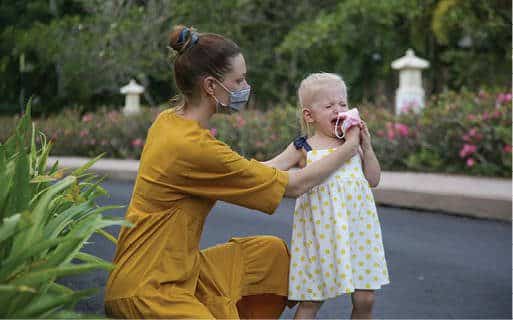
Infants and young children are also vulnerable to the stressors of the pandemic and manifest distress in a variety of ways. Photo: shutterstock/triocean
Service Adaptations
Families with young children continued to come to clinic for in-person well-child care. However, the HS team was required to comply with institutional, state, and federal social distancing guidelines and implement virus mitigation strategies to protect both patients and team members. At the height of the pandemic in spring and summer 2020, the HS team developed a “virtual first” protocol. This protocol involved HS Specialists logging into video meetings (i.e., using video conferencing) on tablets set on wheeled stands, which were then taken to exam rooms by another team member along with necessary paperwork (e.g., HS materials, screeners). Specialists completed HS visits with families over the tablets in the same manner as would be done in person. The tablets allowed HS Specialists to observe child behavior and parent—child interactions and remain integrated during the medical visit while reducing exposure. The HS Specialists were physically located in the same building as the clinic to ensure that a visit could be easily transitioned to in-person if needed. Visits were converted based on factors including families that required phone or tablet interpretation or when risk was identified (e.g., caregiver suicidal ideation, concern about abuse or neglect). At the end of visits, HS Specialists went into exam rooms to give families materials and briefly check in while picking up the tablet. For families who were already being seen by telehealth for follow-up medical visits, HS Specialists joined the visit virtually with medical providers.
In addition to conducting visits via tablets, the HS team identified a need to reach out to all families enrolled in the program, even those not scheduled or due for a visit. HS Specialists reviewed the charts of young children who were previously seen by the team and called families who might benefit from follow up because of missed visits or other psychosocial complexity (e.g., caregiver mental health, history of abuse and neglect, financial strain). When needed, families were invited to come to clinic for necessary well-child care and immunizations, ensuring families remained connected to the medical home. This encouragement proved to be especially important for marginalized families who may have been even more hesitant to come into clinic for fear of contracting the virus. Universal outreach allowed the HS team to connect with families, reassure them of the safety protocols in place at the clinic, and, in some cases, offer telehealth check-ins as an alternative until the family felt safe enough to return to the clinic. The strategy also helped the HS team support the medical team in ensuring that vulnerable families continued to receive support during the pandemic. Families were connected to necessary resources, such as referrals to the Special Supplemental Nutrition Program for Women, Infants, and Children (WIC) and food banks, and offered brief treatment and behavioral health telehealth follow-ups if needed.
The HS team also developed documentation containing important referral information to community resources that medical providers could easily integrate into printed after-visit summaries or send to families through the electronic medical record. Tips on how to keep young children busy and supported emotionally and developmentally were also developed and shared with medical providers for inclusion in the after-visit summary, thereby providing all families with access to this critical information.
Family Supports
The pandemic left many families struggling to obtain basic necessities including food, safe and stable housing, diapers, formula, hand sanitizer, thermometers, and other supplies. In response to these significant needs, the HS team created “wellness bags” to distribute to families during their visits in clinic. The contents of the bags included hand sanitizer, an adult- and a child-sized face mask, cleaning wipes, a thermometer, and written materials (The Moodsters First Aid for Feelings: A Workbook to Help Kids Cope During the Coronavirus Pandemic, Daniels, 2020; and Fighting the Big Virus: Trinka, Sam, and Littletown Work Together, Ghosh Ippen et al., 2020) designed to support families with talking to their young children about the pandemic.
As the pandemic continued into the fall and winter of 2020, the HS team identified a need to support families with creative ways to spend time outside with their young children, even in the cold. The team, in partnership with clinic leadership, established the “Winter Operation–Warmth” or WOW plan. Families received care packages containing wool socks, boots, hats and mittens, and a board game. Written materials included tips for managing pandemic stress for caregivers, recommendations for supporting children across developmental stages, and developmentally supportive activities to do with young children in snowy or cold weather. Beyond these additional supplies, the clinic was already closely partnered with several resource providers including WIC and continued to use a food clinic located in the same building as the primary care clinic.
Provider and Staff Supports
In addition to supporting families with young children, the IBH team and clinic leadership recognized the toll that the pandemic was taking on medical providers and staff. To address this need, the team offered virtual yoga sessions during lunchtime, mindful moments during clinic huddles, and made themselves available to providers needing extra support. Clinic leadership provided frequent meals and snacks, ensured adequate access to personal protective equipment, and dedicated a portion of clinic huddles to express gratitude for everyone’s time and commitment to serving families. Another critical part of supporting providers was in developing the resources and materials for families, which increased providers’ sense of efficacy in addressing patients’ needs. Finally, the IBH team reflected together on issues of racism and inequity exacerbated by the pandemic and discussed ways to promote equitable, accessible care across the clinic. We began a monthly case consultation team meeting and used a reflective practice structure to create a consistent space to explore and address these issues. We also used trauma-informed practices in supervision and team-based care; sought out professional development opportunities related to diversity, equity, and inclusion; and facilitated discussions with medical staff and hospital leadership to address adverse/racist interactions when needed.
Ongoing Adaptations
In the spring and summer of 2021, when vaccinations became more widely available, the HS team began to transition back to an “in-person first” strategy for delivering integrated care. The team slowly began sitting in clinic alongside the medical providers, who had expressed a desire to have the team close by once again. While visits were being conducted in-person once again, the tablets on wheeled stands remained available for families who felt more comfortable meeting with an HS Specialist virtually or if the child or family presented with symptoms consistent with a possible COVID-19 diagnosis. In those cases, the wheeled tablets made it possible for the HS team members to join visits virtually while mitigating the risk of team-member exposure.
Support for families continues to be robust in our clinic, including providing Winter Warmth Bags for a second winter season, connecting families with needed community resources, and screening for and addressing concerns for mental health or social determinants of health. Our clinic also has vaccinations available for children older than 5 years as well as their caregivers. Conversations about vaccinations are common topics for the HS team to address during team-based visits.
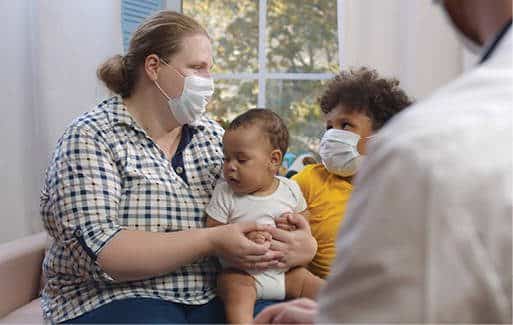
Primary care clinics implementing the HealthySteps model are well suited to address the complex needs of families during the pandemic. Photo: shutterstock/nimito
The team also continues to support providers as the toll of navigating a global pandemic lingers much longer than anyone anticipated. Providers across the medical field (physicians, nurses, medical assistants, mental health providers, and other allied health professionals) are facing unprecedented burnout. Our team works hard to ensure that the providers in our clinic feel supported and appreciated for the work they do to care for young children and their families every day. Sitting with providers in clinic once again, joining well visits with young children, and being available to reflect on the challenges of this work are all strategies being used to support our medical colleagues. These efforts to support providers and staff are rooted in genuine care and concern for our colleagues and the belief that we must “do unto others as you would have others do unto others” (Pawl & St. John, 1998).
Case Example
Sophia was a 9-month-old girl whose family identified as Mexican-American. Sophia lived in a bilingual English-Spanish household with her mother (Maricela), her father (Luis), and her two siblings (Ian, 9 years old, and Valentina, 6 years old).
Sophia initially missed her scheduled well-child check, and the HS team outreached the family to reschedule their visit. On the phone, Maricela expressed concerns about the pandemic, noting that she was especially fearful of entering a medical setting. The HS Specialist reassured Maricela about the safety protocols in place and recommendations to continue to receive well-child care. The HS Specialist also worked to schedule an appointment in the early morning before the family needed the car for Luis to go to work.
On the family needs screener, Maricela identified that she was interested in finding a different early childhood education center for Sophia. When the HS Specialist asked about the current child care arrangement and what Maricela was hoping for, Maricela responded that her current provider had asked Maricela to speak more English at home so that Sophia would be better prepared for school. Maricela emphasized the benefits of dual language exposure and also explained the importance of ensuring Sophia had pride in her culture and her language. Maricela briefly mentioned that her own immigration status might limit the early childhood education options available to Sophia in the community.
Maricela also screened positive for food insecurity and electricity concerns. She noted that she had lost hours of work because of the pandemic but was unsure what benefits she would be entitled to given her immigration status. The HS Specialist was able to communicate this information to the Community Health Navigator team, who provided Maricela with food, diapers, and information regarding programs that were not dependent on immigration status.
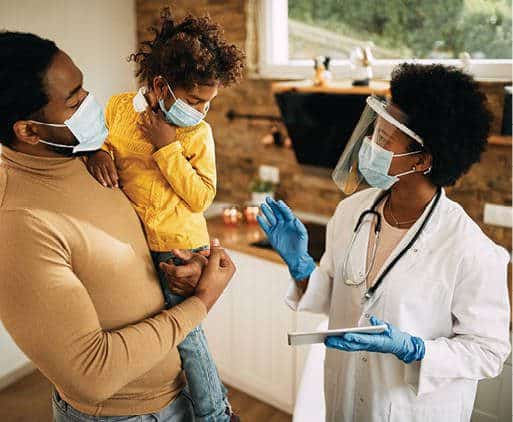
Often issues of complicated family structures and dynamics were the focus of understanding how best to consider the child’s symptoms and the child’s relational and cultural context. Photo: shutterstock/Dragan Zigic
Maricela also described feeling nervous as a frontline worker, noting that her older children often asked her to stay home so that she would not become ill. The HS Specialist held space for this worry, discussed the ways that she was protecting herself, and validated the unequal burden of the pandemic on many frontline workers and communities of color. She also provided Maricela with a Fighting the Big Virus: Trinka, Sam, and Littletown Work Together (Ghosh Ippen et al., 2020) book to help provide psychoeducation for Maricela’s older children.
Maricela left the visit thankful for the space to talk about her family’s well-being, relieved that the family’s psychosocial needs were addressed, and more comfortable to return to the clinic as the pandemic continued.
Conclusion
Primary care is, by design, a trusting environment for families with young children to seek guidance and support and have their children’s health and well-being closely monitored. Primary care has always been an essential service for young children with approximately 91.9% of young children in the United States attending well-child care (Centers for Disease Control and Prevention, 2020). During early childhood, primary care settings provide ample opportunities for health promotion and prevention. Primary care settings are also well-positioned to provide early identification and intervention by addressing concerns as they arise and before they become crises. During the beginning stages of the pandemic, primary care became even more essential, as it was one of the only places providing in-person care to young children.
Early childhood IBH strategies, such as the HS model, enhance early childhood primary care experiences, emphasizing whole-child and whole-family care. Clinics with established HS services were already providing comprehensive, integrated care to young children and their families. During the incredibly tumultuous time of the pandemic, HS served as the foundation for rapidly adapting and delivering critical primary care services. Adjustments needed to be made to adhere to virus mitigation and safety protocols while simultaneously identifying and addressing the increased needs of young children and families that arose during the pandemic.
This clinic prioritized HS services throughout the pandemic by quickly adapting existing workflows to ensure the continuation of preventive care. Necessary safety protocols and mitigation efforts (e.g., social distancing, personal protective equipment) required the team to be creative and adapt their processes in order to continue to provide comprehensive support to young children and families. HS interventions continue to be important, nearly 2 years later, as families are still grappling with the mental health and economic consequences of the pandemic and continue to benefit from health promotion and prevention at routine visits.
Pandemic Response Recommendations
The following suggestions are based on experiences throughout the pandemic requiring significant and ongoing adaptation to our workflows:
- Flexibility is key. Teams must be willing and able to pivot workflows and processes to respond to the needs of families and ensure family and team member safety.
- Prioritize behavioral health and prevention services for young children. Prevention and early intervention services are more important than ever, particularly at a time when other services and supports are significantly less accessible.
- Mitigate disparities by universally delivering equitable, accessible, acceptable, and high-quality care to young children and their families. Addressing systemic barriers to care, structural and institutional racism, and discriminatory and oppressive practices is critical in reducing disparities and mitigating the impact of social determinants of health on minoritized and marginalized families. We found it essential to reflect on these disparities as a team, developed a monthly case consultation team reflective practice, and openly discuss issues of racial disparities with our medical colleagues.
- Think outside the box. The role of IBH providers will likely need to expand beyond family support while also including support for the well-being of primary care providers who are physically and emotionally stretched and stressed.
- Maintain a clear understanding of community resources and how they are being delivered (e.g., telehealth, phone). When making referrals to community agencies, it is important to prepare families regarding what types of services they can expect.
- Use technology to increase access to care. Create hybrid approaches that can meet the needs of families with young children by offering in-person and virtual visits.
- Promote team-based wellness. Ensuring the health and well-being of providers and staff is critical in delivering high-quality services over a prolonged period where circumstances are difficult and hope is hard to find.
- Outreach vulnerable families by leveraging established relationships. Developing ongoing and trusting relationships with families and proactively outreaching those who may benefit from extra support can ensure that families receive the help they need.
- Address unmet needs. Many families required additional support for caregiver well-being, were struggling with material resources, or were experiencing mood and anxiety symptoms. Helping families with concrete support and adapting services and interventions helps deepen existing relationships and contributes to overall family well-being.
Author Bios
Melissa Buchholz, PsyD, is a licensed clinical psychologist and associate professor at the University of Colorado School of Medicine in the Departments of Psychiatry and Pediatrics. She is a member of the core faculty for the Irving Harris Program for Child Development and Infant Mental Health at the University of Colorado. Dr. Buchholz is the director of HealthySteps for the state of Colorado and has worked to scale this model across the state since 2012. She is passionate about disseminating health promotion and prevention services for young children and has spent her career focusing on integrating early childhood behavioral health services into medical settings, specifically pediatric primary care. Dr. Buchholz is particularly interested in improving access to behavioral health care for young children and building comprehensive systems of care for young children and their families. Dr. Buchholz is graduate of ZERO TO THREE’s fellowship and a member of the Academy of Fellows at ZERO TO THREE.
Kelly Glaze, PsyD, is an assistant professor with the Harris Program in Child Development and Infant Mental Health in the Department of Psychiatry at the University of Colorado School of Medicine. Dr. Glaze is a licensed clinical psychologist and directs the Harris Expansion Community Fellowship Program, which provides a year-long, intensive training opportunity for mental health clinicians across the state of Colorado. She also acts as a supervising psychologist in the Child Health Clinic at Children’s Hospital Colorado overseeing the integrated behavioral health team. In addition, Dr. Glaze provides clinical care and reflective supervision as part of the Warm Connections Program—a partnership between the Special Supplemental Nutrition Program for Women, Infants, and Children (WIC) and the University of Colorado offering integrated mental health services to underserved women, infants, and children.
Catherine Wolcott, PhD, is a licensed clinical psychologist and an assistant professor at the University of Colorado School of Medicine. Her work focuses on delivering integrated primary care services for pregnant parents and young children and offering Spanish supervision for psychology trainees. Her interests include group-based behavioral health services for young children and pregnant women in primary care, access to culturally sensitive mental health care for Latinx families, and addressing exposure to toxic stress and trauma in demographically at-risk populations.
Ayelet Talmi, PhD, is a professor in the Departments of Psychiatry and Pediatrics at the University of Colorado School of Medicine and a licensed clinical psychologist. Dr. Talmi is the director of the Section of Integrated Behavioral Health in the Child and Adolescent Mental Health Division of the Department of Psychiatry, a director of the Irving Harris Program in Child Development and Infant Mental Health, and the director of Project CLIMB. Dr. Talmi has been engaged in early childhood and integrated behavioral health systems building efforts, direct service, advocacy, and policy in Colorado and nationally. Her primary clinical and research interests focus on behavioral health service delivery systems for children and families, integrated behavioral health in primary care and community settings, early childhood mental health, and young children with special health care needs. Dr. Talmi is a past president of the Colorado Association for Infant Mental Health and a Graduate Fellow of ZERO TO THREE’s Leaders for the 21st Century Fellowship.
Suggested Citation
Buchholz, M., Glaze, K., Wolcott, C., Talmi, A. (2022). Pivoting during a pandemic: Innovative strategies for supporting young children in primary care. ZERO TO THREE Journal, 42(3), 24–30.
References
American Academy of Pediatrics. (2020, April 15). Guidance on providing pediatric ambulatory services via telehealth during COVID-19. link
American Academy of Pediatrics. (2021, August 2). Supporting emotional, behavioral needs of children in the pandemic: Updated guidance. link
Asarnow, J. R., Kolko, D. J., Miranda, J., & Kazak, A. E. (2017). The pediatric patient-centered medical home: Innovative models for improving behavioral health. American Psychologist, 72(1), 13–27.
Brown, S. M., Doom, J. R., Lechuga-Peña, S., Watamura, S. E., & Koppels, T. (2020). Stress and parenting during the global COVID-19 pandemic. Child Abuse & Neglect, 110(Pt 2). 104699. doi: 10.1016/j.chiabu.2020.104699. Epub 2020 Aug 20. PMID: 32859394; PMCID: PMC7440155. link
Buchholz, M., Burnett, B., Margolis, K., Millar, A., & Talmi, A. (2018). Early childhood behavioral health integration activities and HealthySteps: Sustaining practice, averting costs. Clinical Practice in Pediatric Psychology, 6(2), 140–151. doi: 10.1037/cpp0000239.
Buchholz, M., & Talmi, A. (2012). What we talked about at the pediatrician’s office: Exploring differences between Healthy Steps and traditional pediatric primary care visits. Infant Mental Health Journal, 33(4), 430–436.
Center on Budget Policy Priorities. (2021). Special series COVID hardship watch—Tracking the COVID-19 economy’s effects on food, housing and employment hardships. link
Centers for Disease Control and Prevention. (2020). QuickStats: Percentage of children ages <18 years who received a well-child checkup in the past 12 months, by age group and year—National Health Interview Study, United States, 2008 and 2018. Morbidity and Mortality Weekly Report, 690222. DOI: http://dx.doi.org/10.15585/mmwr.mm6908a5offsite link. link
Chung, G., Lanier, P., & Wong, P. Y. J. (2020). Mediating effects of parental stress on harsh parenting and parent-child relationship during coronavirus (COVID-19) pandemic in Singapore. Journal of Family Violence, 1–12. Advance online publication. https://doi.org/10.1007/s10896-020-00200-1offsite link. link
Daniels, D. (2020). The Moodsters first aid for feelings: A workbook to help kids cope with the Coronavirus pandemic. Scholastic.
Felitti, V. J, Anda, R. F., Nordenberg, D., Williamson, D. F., Spitz, A. M., Edwards, V., Koss, M. P., & Marks, J. S. (1998). Relationship of childhood abuse and household dysfunction to many of the leading causes of death in adults: The Adverse Childhood Experiences (ACE) Study. American Journal of Preventive Medicine, 14(4), 245–258.
Friedman, J., York, H., Mokdad, A. H., & Gakidou, E. (2021). U.S. children “learning online” during COVID-19 without the internet or a computer: Visualizing the gradient by race/ethnicity and parental educational attainment. Socius: Sociological Research for a Dynamic World, 7, 237802312199260.
Ghosh Ippen, C., Brymer, M., & Ippen, E. (2020). Fighting the big virus: Trinka, Sam, and Littletown work together. Piplo Productions.
Guyer, B., Barth, M., Bishai, D., Caughy, M., Clark, B., Burkom, D., Grason, H., Hou, W., Huang, K., Hughart, N., Jones, A. S., McLearn, K. T., Miller, T., Minkovitz, C., Scharfstein, D., Stacy, H., Strobino, D., Szanton, E., Genevro, J., & Tang, C. (2003). Healthy Steps: The first three years: The Healthy Steps for Young Children Program national evaluation. Johns Hopkins Bloomberg School of Public Health.
Johnston, B. D, Huebner, C. E., Tyll, L. T., Barlow, W. E., & Thompson, R. S. (2004). Expanding developmental and behavioral services for newborns in primary care: Effects on parental well-being, practice, and satisfaction. American Journal of Preventative Medicine, 26(4), 356–366.
Klein, J. D., Koletzko, B., El-Shabrawi, M. H., Hadjipanayis, A., Thacker, N., & Bhutta, Z. (2020). Promoting and supporting children’s health and healthcare during COVID-19–International Paediatric Association Position Statement. Archives of Disease in Childhood, 105(7), 620–624.
Lakhan, R., Agrawal, A., & Sharma, M. (2020). Prevalence of depression, anxiety, and stress during COVID-19 pandemic. Journal of Neurosciences in Rural Practice, 11(4), 519–525.
Leslie, E., & Wilson, R. (2020). Sheltering in place and domestic violence: Evidence from calls for service during COVID-19. Journal of Public Economics, 189, 1–7.
Moreland, A., Herlihy, C., Tynan, M. A., Sunshine, G., McCord, R. F., Hilton, C., Poovey, J., Werner, A. K., Jones, C. D., Fulmer, E. B., Gundlapalli, A. V., Strosnider, H., Potvien, A., García, M. C., Honeycutt, S., & Baldwin, G. (2020). Timing of state and territorial COVID-19 stay-at-home orders and changes in population movement—United States, March 1-May 31, 2020. Morbidity and Mortality Weekly Report, 69(35), 1198–1203.
National Center for Health Statistics. (2020). Anxiety and depression: Household pulse survey. link
Park, C. L., Russell, B. S., Fendrich, M., Finkelstein-Fox, L., Hutchison, M., & Becker, J. (2020). Americans’ COVID-19 stress, coping, and adherence to CDC guidelines. Journal of General Internal Medicine: JGIM, 35(8), 2296–2303.
Patrick, S., Henkhaus, L., Zickafoose, J., Lovell, K., Halvorse, A., Loch, S., Letterie, M., & Davis, M. (2020). Wellbeing of parents and children during the COVID 19 pandemic: A national survey. Pediatrics, 146(4), e2020016824.
Pawl, J., & St. John, M. (1998). How you are is as important as what you do in making a positive difference for infants, toddlers and their families. ZERO TO THREE.
Petruccelli, K., Davis, J., & Berman, T. (2019). Adverse childhood experiences and associated health outcomes: A systematic review and meta-analysis. Child Abuse & Neglect, 97, 104–127.
Pew Research Center. (2020). Covid 19: Effect on personal life. link
Piotrowski, C. C, Talavera, G. A., & Mayer, J. A. (2009). Healthy Steps: A systematic review of a preventative practice-based model of pediatric care. Journal of Developmental and Behavioral Pediatrics, 30(1), 91–103.
Salari, N., Hosseinian-Far, A., Jalali, R., Vaisi-Raygani, A., Rasoulpoor, S., Mohammadi, M., Rasoupoor, S., & Khaledi-Paveh, B. (2020). Prevalence of stress, anxiety, depression among the general population during the COVID-19 pandemic: A systematic review and meta-analysis. Globalization and Health, 16(1), 57.
Shonkoff, J., Garner, A., Committee on Psychosocial Aspects of Child Family Health, Committee on Early Childhood, Adoption, Dependent Care, and Section on Developmental Behavioral and Pediatrics. (2012). The lifelong effects of early childhood adversity and toxic stress. Pediatrics (Evanston), 129(1), E232–E246.
Tai, D. B. G., Shah, A., Doubeni, C. A., Sia, I. G., & Wieland, M. L. (2021). The disproportionate impact of COVID-19 on racial and ethnic minorities in the United States. Clinical Infectious Diseases, 72(4), 703–706.
Talmi, A., Muther, E., Margolis, K., Buchholz, M., Asherin, R., & Bunik M. (2016). The scope of behavioral health integration in a pediatric primary care setting. Journal of Pediatric Psychology, 41(10), 1120–1132.
Twenge, J. M., & Joiner, T. E. (2020). Mental distress among U.S. adults during the COVID-19 pandemic. Journal of Clinical Psychology, 76(12), 2170–2182.

